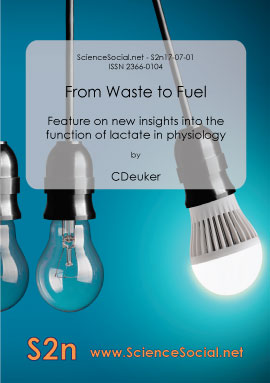 From Waste to Fuel.
From Waste to Fuel.
New insights into the function of lactate in physiology
Feature by
CDeuker
1 Content
1 Content
2 Abstract
3 References
4 End of Pipe – the former explanation
5 The Lactate Shuttle Revolution
2 Abstract
Lately I read a paper about new insights into the function of lactate that really thrilled me [Wahl, P.; 2009]. In this paper, everything I learned at University about energy physiology in muscles was upside down and together with this new paradigm, some problems between theory and practical experiences we used to discuss vanished instantly.
This S2n – Feature describes the new Lactate Shuttle physiology [s. Brooks, G. A.; 1985b] in contrast to the former theory of muscle energy metabolisms. Beginning with a short review to the old theory of muscle physiology, the radical change to these findings of lactate shuttle illustrate the new paradigm. The aim of this feature is not to recapitulate all details of contemporary research in physiology, but to point out the fundamental effects of the lactate shuttle to physiology with regard to energy consumption.
3 References
Brooks, G. A.; 1985a; “Anaerobic threshold: review of the concept and directions for future research”; 22-31; Medicine & Science in Sports & Exercise; 0195-9131; 17/1; http://journals.lww.com/acsm-msse/Fulltext/1985/02000/Anaerobic_threshold__review_of_the_concept_and.5.aspx
Brooks, G. A.; 1985b; “Lactate:Glycolytic End Product and Oxidative Substrate During Sustained Exercise in Mammals — The “Lactate Shuttle””; 208-218; In: Gilles, R.;”Circulation, Respiration, and Metabolism: Current Comparative Approaches”; Berlin, Heidelberg; Springer Berlin Heidelberg
Brooks, G. A.; 2002; “Lactate shuttles in nature”; 258-264; Biochemical Society Transactions; 0300-5127 (Print); 30/part 2;
Brooks, G. A.; 2007; “Lactate. Link Between Glycolytic and Oxidative Metabolism”; 341-343; Sports Medicine; 1179-2035; 37/4; http://dx.doi.org/10.2165/00007256-200737040-00017
Cruz, R. S. d. O.; de Aguiar, R. A.; Turnes, T.; Penteado Dos Santos, R.; Fernandes Mendes de Oliveira, M.; Caputo, F.; 2012; “Intracellular Shuttle: The Lactate Aerobic Metabolism”; 420984; The Scientific World Journal; 1537-744X; 2012/http://www.ncbi.nlm.nih.gov/pmc/articles/PMC3345575/
de Marées, H.; 1992; “Sportphysiologie”; Köln-Mülheim; Tropon-Werke;
Gladden, L. B.; 2004; “Lactate metabolism: a new paradigm for the third millennium”; 5-30; The Journal of Physiology; 1469-7793; 558/1; http://dx.doi.org/10.1113/jphysiol.2003.058701
Holfelder, B.; Bubeck, D.; 2012; “Theoretische Betrachtungen über die Trainingssteuerung anhand des Laktatstoffwechsels und der Muskelfasertypisierung”; 32-39; Schweizerische Zeitschrift für «Sportmedizin und Sporttraumatologie»; 1022-6699, online 1422-0644; 60/1;
Knechtle, B.; 2002; “Sportphysiologie: Leistung und Ernährung im Sport”; Basel, Freiburg, Paris, London, New York, New Delhi, Bankok, Singapore, Tokyo, Sydney; Karger; 3-8055-7457-6
Küster, L.; 2009; “Leistungsdiagnostik in Sportmedizin und Sportwissenschaft”; Saabrücken; VDM Verlag Dr. Müller; 978-3-639-17437-3
Laube, W.; 2009a; “Diagnostik der Leistungen des sensomotorischen Systems: Koordination – ausdauer – Kraft”; 228-274; In: Laube, W.;”Sensomotorisches System”; Stuttgart; Thieme Verlag
Laube, W.; 2009b; “Logistiksysteme des sensomotorischen Systems: die funktionelle Kette der aeroben Energieversorgung – Regulationssysteme der Homöoestase und der Koordination der Organfunktionen”; 118-164; In: Laube, W.;”Sensomotorisches System”; Stuttgart; Thieme Verlag
Tomasits, J.; Haber, P.; 2011; “Leistungsphysiologie. Grundlagen für Trainer, Physiotherapeuten und Masseure”; Wien; SpringerWienNewYork; 978-3-7091-0436-1
Wahl, P.; 2009; “Moderne Betrachtungsweisen des Laktats : Laktat ein überschätztes und zugleich unterschätztes Molekül”; 100-107; Schweizerische Zeitschrift für «Sportmedizin und Sporttraumatologie»; 1022-6699, online 1422-0644; 57/3; http://www.sgsm.ch/publikationen/swiss-sports-exercise-medicine/
4 End of Pipe – the former explanation
The fitness hype got a tremendous push recently by wearables like fitness trackers. For athletes all these are only additionally information, nice to have, but dominated by one variable – the heart rate. One reason is that the heart rate is easy to measure even in action. More significant, beyond all this information to movement and acceleration, the heart rate is directly connected to performance capabilities of the body. And the idea of training is to push up exercise performance to an higher level. The question is how to do this efficiently with regard to exhaustion and energy resources. Out of experience in sports as well as the classification of different competitions, it is obvious that there are two realms – sprint and endurance. That is exactly what muscle physiology tells with fast and slow switching muscle fibers and many mixtures of these structures. The fast switching fibers can quickly contract and produce powerful forces with a high exhaustion rate and vice versa the slow switching fibers. Because this feature focuses on energy metabolisms and not anatomic specification of muscles, no further explanations to this vast and interesting field follows.
Similarly to the muscle anatomy, the metabolisms of energy are divided in two different realms: aerobic and anaerobic which describe the way of phosphate recycling. In muscles, as in every cell, energy is used in forms of phosphate like ATP (Adenosine triphosphate). In contrast to modern agriculture, the evolution discovered that phosphate is limited and scares in nature and developed extremely effective processes in phosphate recycling. Our energy resources of carbs, fat or proteins are used for this phosphate recycling in the Krebs-Cycle and the respiration chain [s. Laube, W.; 2009b; 141].
read more…
For S2n members only – please log in or become S2n member.
Or bill me with email (read only for Windows with free CopySavePDF reader) €7,- for S2n-Features